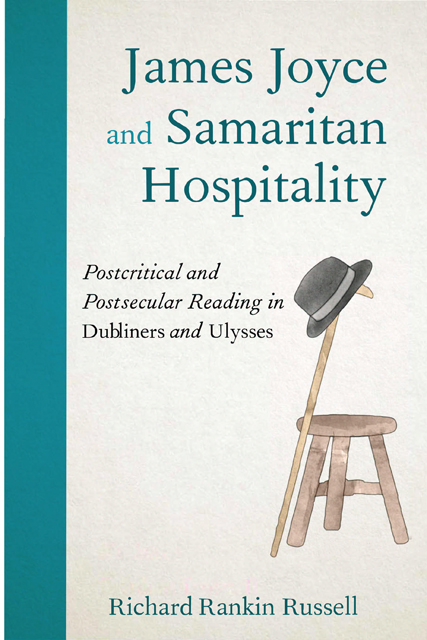Book contents
- Frontmatter
- Contents
- Preface and Acknowledgments
- List of Abbreviations
- Introduction
- 1 Haunted by Hospitality in “The Dead”
- 2 Joyce, Scripture, and Autobiographical Rescue Narratives
- 3 Rewriting the Good Samaritan Parable: The Fictional Rescue Narratives of “Grace” and “Circe”
- 4 Bloom as Stranger and Samaritan in “Cyclops,” “Oxen of the Sun,” and “Circe”
- 5 “In orthodox Samaritan fashion”: The Parabolic Encounter between Stephen and Bloom in “Eumaeus”
- 6 Home to “Ithaca” and “Penelope”: Bloom’s Hospitality and Stephen and Molly’s Reactions
- 7 Enfleshed Ethics and the Responsibility of the Reader in the Good Samaritan Parable and the “Nostos” of Ulysses
- Coda: “Go thou and do likewise”: Postcritical and Postsecular Reading through a Joycean Hermeneutics of Hospitality
- Works Cited
- Index
Introduction
Published online by Cambridge University Press: 25 April 2023
- Frontmatter
- Contents
- Preface and Acknowledgments
- List of Abbreviations
- Introduction
- 1 Haunted by Hospitality in “The Dead”
- 2 Joyce, Scripture, and Autobiographical Rescue Narratives
- 3 Rewriting the Good Samaritan Parable: The Fictional Rescue Narratives of “Grace” and “Circe”
- 4 Bloom as Stranger and Samaritan in “Cyclops,” “Oxen of the Sun,” and “Circe”
- 5 “In orthodox Samaritan fashion”: The Parabolic Encounter between Stephen and Bloom in “Eumaeus”
- 6 Home to “Ithaca” and “Penelope”: Bloom’s Hospitality and Stephen and Molly’s Reactions
- 7 Enfleshed Ethics and the Responsibility of the Reader in the Good Samaritan Parable and the “Nostos” of Ulysses
- Coda: “Go thou and do likewise”: Postcritical and Postsecular Reading through a Joycean Hermeneutics of Hospitality
- Works Cited
- Index
Summary
Creative and Caring Reading in Joyce
On July 24, 2010, the Irish Independent ran a story that might have been startling for those familiar with the alleged origins of James Joyce’s Ulysses. The paper’s security editor, Tom Brady, reported that “A man was in garda custody last night after a father-to-be was stabbed to death when he attempted to break up a row. Good Samaritan James Joyce (20) was struck several times in the upper body with a domestic knife.” The writer James Joyce was also putatively involved in a fight 106 years before this incident and was rescued by a Good Samaritan—or so the legend goes. The truth, however, is much more complicated. And understanding this likely apocryphal incident and its effect on Joyce and Ulysses reveals a writer and a novel indebted to this specific parable and to Scripture more generally.
Ulysses gradually reveals the faultiness of Stephen Dedalus’s notion of hyperelitist artistic predestination and his embrace of extreme atomistic individualism derived from a caricature of the Reformation in A Portrait of the Artist as a Young Man by showing him slowly moving into a type of heterogeneous community epitomized by Christ’s pluralist parable of the Good Samaritan. The question of what it means to be a neighbor—a good neighbor, even—dominates much of Joyce’s Ulysses and became increasingly important to the peripatetic Joyce while in exile from Ireland. While living in Rome in 1906, he regretted not reproducing in Dubliners the “hospitality” of Dublin, which he claimed to his brother Stanislaus, “does not exist elsewhere in Europe” (SL 110). The two central characters of Ulysses, Stephen and Leopold Bloom, are often rebuffed by their neighbors—Stephen by Buck Mulligan and Haines, Bloom by a whole series of Dubliners—and gradually drift toward each other. The central, long-planned-for event of the novel occurs with their meeting in the second half of the “Oxen of the Sun” episode and continues through the apocalyptic, overly long “Circe” episode, and the parabolic episodes of “Eumaeus” and “Ithaca,” even “Penelope.” Bloom tries to be neighborly to Stephen, fatherly even, and his actions here and earlier in encounters with others in the novel are depicted as re-enactments of the Good Samaritan parable, perhaps Jesus’ most famous story of this kind in Scripture.
- Type
- Chapter
- Information
- James Joyce and Samaritan HospitalityPostcritical and Postsecular Reading in Dubliners and Ulysses, pp. 1 - 18Publisher: Edinburgh University PressPrint publication year: 2023



